Related Research Articles

William Chester Minor, was an American army surgeon, psychiatric-hospital patient, and lexicographical researcher.

Bronisław Kasper Malinowski was a Polish-British anthropologist and ethnologist whose writings on ethnography, social theory, and field research have exerted a lasting influence on the discipline of anthropology.

Brookwood Cemetery, also known as the London Necropolis, is a burial ground in Brookwood, Surrey, England. It is the largest cemetery in the United Kingdom and one of the largest in Europe. The cemetery is listed a Grade I site in the Register of Historic Parks and Gardens.
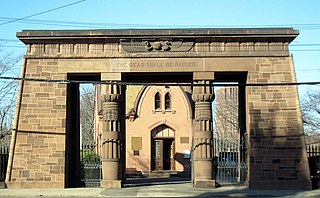
Grove Street Cemetery or Grove Street Burial Ground is a cemetery in New Haven, Connecticut, that is surrounded by the Yale University campus. It was organized in 1796 as the New Haven Burying Ground and incorporated in October 1797 to replace the crowded burial ground on the New Haven Green. The first private, nonprofit cemetery in the world, it was one of the earliest burial grounds to have a planned layout, with plots permanently owned by individual families, a structured arrangement of ornamental plantings, and paved and named streets and avenues. By introducing ideas like permanent memorials and the sanctity of the deceased body, the cemetery became "a real turning point... a whole redefinition of how people viewed death and dying", according to historian Peter Dobkin Hall. Many notable Yale and New Haven luminaries are buried in the Grove Street Cemetery, including 14 Yale presidents; nevertheless, it was not restricted to members of the upper class, and was open to all.

Key Hill Cemetery,, originally called Birmingham General Cemetery, is a cemetery in Hockley, Birmingham, England. It opened in 1836 as a nondenominational cemetery, and is the oldest cemetery, not being in a churchyard, in Birmingham. The principal entrance is on Icknield Street to the west, with a secondary entrance on Key Hill to the north. The cemetery contains the graves of many prominent members of Birmingham society in the late 19th century, to the extent that in 1915 E. H. Manning felt able to dub it "the Westminster Abbey of the Midlands".
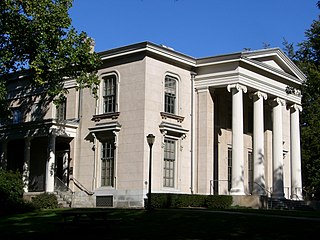
Hillhouse Avenue is a street in New Haven, Connecticut, famous for its many nineteenth century mansions, including the president's house at Yale University. Both Charles Dickens and Mark Twain have described it as "the most beautiful street in America." Much of the avenue is included in the Hillhouse Avenue Historic District, which extends to include houses on adjacent streets.

The Center Street Cemetery is a historic cemetery on Center Street in Wallingford, Connecticut. Established about 1670, it is the town's oldest cemetery, and the burial site for many of the city's civic and industrial leaders. It was listed on the National Register of Historic Places in 1997.

Joseph Earle Sheffield was an American railroad magnate and philanthropist.

Connecticut Route 10 is a state highway that runs between New Haven and the state line near Granby. It continues north of the state line as Massachusetts Route 10, which in turn continues directly to New Hampshire Route 10.
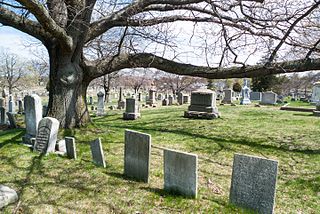
The North Burial Ground is a 110-acre (0.45 km2) cemetery in Providence, Rhode Island dating to 1700, the first public cemetery in Providence. It is located north of downtown Providence, bounded by North Main Street, Branch Avenue, the Moshassuck River, and Cemetery Street. Its main entrance is at the junction of Branch and North Main. The burial ground is one of the larger municipal cemeteries in Southern New England, and it accepts 220 to 225 burials per year.
Dixwell is a neighborhood of New Haven, Connecticut. Named for Dixwell Avenue, the main thoroughfare of the neighborhood which in turn was named for regicide judge John Dixwell, it is situated generally northwest of and adjacent to Downtown New Haven.

Cedar Hill Cemetery in Hartford, Connecticut is located at 453 Fairfield Avenue. It was designed by landscape architect Jacob Weidenmann (1829–1893) who also designed Hartford's Bushnell Park. Its first sections were completed in 1866 and the first burial took place on July 17, 1866. Cedar Hill was designed as an American rural cemetery in the tradition of Mount Auburn Cemetery in Cambridge, Massachusetts.
Newhallville is a neighborhood in the city of New Haven, Connecticut, named for industrialist George Newhall.
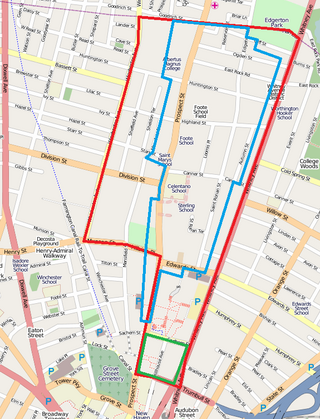
Prospect Hill is a neighborhood of the city of New Haven, Connecticut located in the north central portion of the city, directly north of Downtown New Haven. The neighborhood contains residences, institutional buildings of Albertus Magnus University and a portion of the main campus of Yale University, including the Science Hill area, the Hillhouse Avenue area and the Yale Peabody Museum. The City of New Haven defines the neighborhood to be the region bounded by the town of Hamden in the north, Winchester Avenue in the west, Munson Street/Hillside Place/Prospect Street in the southwest, Trumbull Street in the south, and Whitney Avenue in the east. Prospect Street is the main thoroughfare through the neighborhood.

Kan'ichi Asakawa was a Japanese academic, author, historian, librarian, curator and peace advocate. Asakawa was Japanese by birth and citizenship, but he lived the major portion of his life in the United States.
West River is an official neighborhood of the city of New Haven, Connecticut. The neighborhood covers the part of the city east of the West River and south of Chapel Street. Official planning maps run the eastern and southern boundaries run along Day Street, Legion Avenue, Winthrop Avenue, and Davenport Avenue. The neighborhood is bounded by the Edgewood, Dwight, and Hill (south) neighborhoods. The neighborhood includes West River Memorial Park and Evergreen Cemetery. The Hospital of St. Raphael is also included within the official neighborhood planning area.

Leoni W. Robinson (1851-1923) was a leading architect in New Haven, Connecticut.

John Addison Porter was an American journalist, and the first person to hold the position of "Secretary to the President". He was born in New Haven, Connecticut and died in Pomfret, Connecticut.
The Cedar Grove Cemetery is a non-sectarian rural cemetery in New London, Connecticut. It was established in 1851 on 39 acres and designed by Dr. Horatio Stone. The cemetery is located at the intersection of Broad Street and Jefferson Avenue.
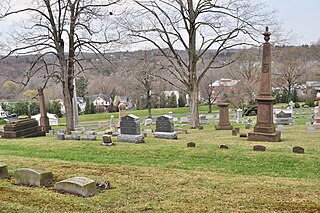
Indian Hill Cemetery is a historic rural cemetery located at 383 Washington Street in Middletown, Connecticut on a hill adjacent to Wesleyan University.
References
- 1 2 3 4 McDonough, Cara (24 January 2013). "Lives and Times". The Daily Nutmeg. Retrieved 12 November 2015.
- ↑ "Evergreen Cemetery & Crematory | A Haven of Tranquility... A Tradition of Service". www.evergreencem.org. Archived from the original on 2011-10-21.
- ↑ "Obituary Record of Graduates of Yale University Deceased During the Year 1940–1941" (PDF). Yale University. January 1, 1942. pp. 7–8. Retrieved December 15, 2022.
- ↑ Wayne, H. (1995). The Story of a Marriage: The Letters of Bronisław Malinowski and Elsie Masson. London: Routledge. p. 241.
- 1 2 3 4 5 6 7 "Evergreen Cemetery: Search Burial Records". www.evergreencem.org. Evergreen Cemetery. Retrieved 24 January 2015.
- ↑ CWGC casualty record.